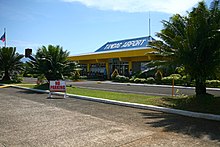Tandag
Another version states that when Spanish-Peruvian historian and explorer Inca Garcilaso de la Vega landed in Tandag to subdue the ferocious Caragas (as the rebellious natives were called then), he did not know the name of the place so he inquired from a native who was gathering the leaves of an herb locally known as tanglad.When they asked for correct directions, the natives, who could not understand Spanish, merely laughed at them, continually saying the word "tarantados", meaning 'lost'.Long before Tandag became what it is today—the bustling capital town of Surigao del Sur was inhabited by the Manobos and the Mamanwas who lived along the river banks under the leadership of Suba, their Chieftain.Suba was later converted into Christianity by Father Juan de la Encarnacion, a Spanish missionary.After Legazpi’s final conquest to the Philippines in 1609, the Spanish government sent missionaries accompanied by platoons of guardia civil to subdue the hostile natives.It is still believed that somewhere underneath the sea near Tandag's Linungao Islands lies a sunken galleon ship.After the Spanish missionaries' visit to Tandag, a group of Italian explorers and soldiers then landed in the city.Strict compliance was enforced during those times, which explains why Italian became Tandag's local dialect aside from the mainstay Surigaonon.On December 22, 2009, the cityhood law of Tandag and 15 other municipalities regain its status as cities again after the court reversed its ruling on November 18, 2008.On August 23, 2010, the court reinstated its ruling on November 18, 2008, causing Tandag and 15 cities to become regular municipalities.Finally, on February 15, 2011, Tandag becomes a city again including the 15 municipalities declaring that the conversion to cityhood met all legal requirements.











PhilippinesRegionCaragaProvinceSurigao del Sur
1st districtBarangaysSangguniang PanlungsodVice MayorCity CouncilEconomyPoverty incidenceRevenueAssetsExpenditureLiabilitiesElectricityTime zoneZIP codearea codeSurigaononCebuanoFilipinosecondary airportnativeInca Garcilaso de la VegatangladLegazpiSpanish galleonsMindanaoAgusan del SurAgusan del NorteSurigao del NortecottasJesuitIliganpriorySecond World WartyphoonsWorld War IIJapanese occupationguerrilla presenceCities of the PhilippinesLeague of Cities of the Philippines v. COMELECSupreme CourtLeague of Cities of the PhilippinesCortesLanuzaPhilippine SeaSan MiguelSibagatManilaSurigao CityDavao Citypurokssitiostropical rainforest climatePhilippine Statistics AuthorityEnglishGaisano CapitalGaisano familyfeast daySan Nicolas de Tolentinopatron saintnovenaLocal Government UnitSanto NiñoSinulog festivalGymnasiumskim boardingFrisbeebeach volleyballPlantationWild LifeWild Life ConservationMangrovesTricyclePedicabJeepneyTandag AirportFrancisco Bangoy (Davao) International AirportPhilippine AirlinesCebu PacificSurigao AirportBancasi (Butuan) AirportButuanMulticabsjeepneysSan Francisco, Agusan del SurBisligPhiltrancoCantilanCokaliong Shipping LinesAdela Serra Ty Memorial Medical CenterAdela Serra TyPhilippine Red CrossJacinto P. Elpa National High SchoolTandag National Science High SchoolNorth Eastern Mindanao State University89.3 MHz Real RadioPEC Broadcasting CorporationSt. Jude Thaddeus Institute of TechnologyBrigada Mass Media Corporation95.9 MHz Radyo NatinManila Broadcasting CompanyRadyo Natin NetworkUltrasonic Broadcasting System97.5 MHz Shure FMIddes Broadcast GroupCapitol Broadcasting CenterBandera News PhilippinesPrime Broadcasting NetworkPalawan Broadcasting CorporationPhilippine Broadcasting Service93.9 MHz iFM Davao "Ang Best Friend Mo!"desktopGMA NetworkABS-CBNABS-CBN Sports+ActionCignal Digital TVGlobe BroadbandPLDT Home BroSmart BroGlobe TelecomSmart CommunicationsDito Telecommunity